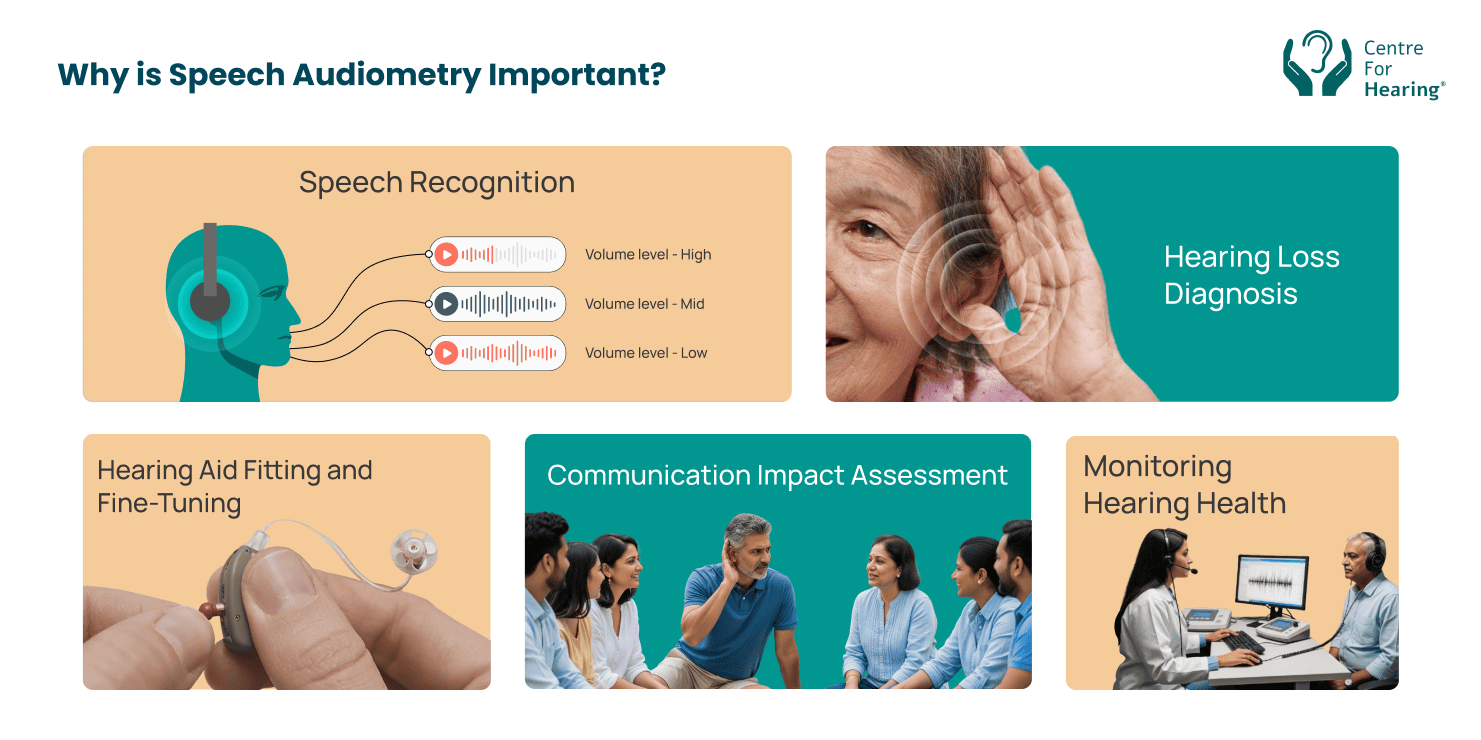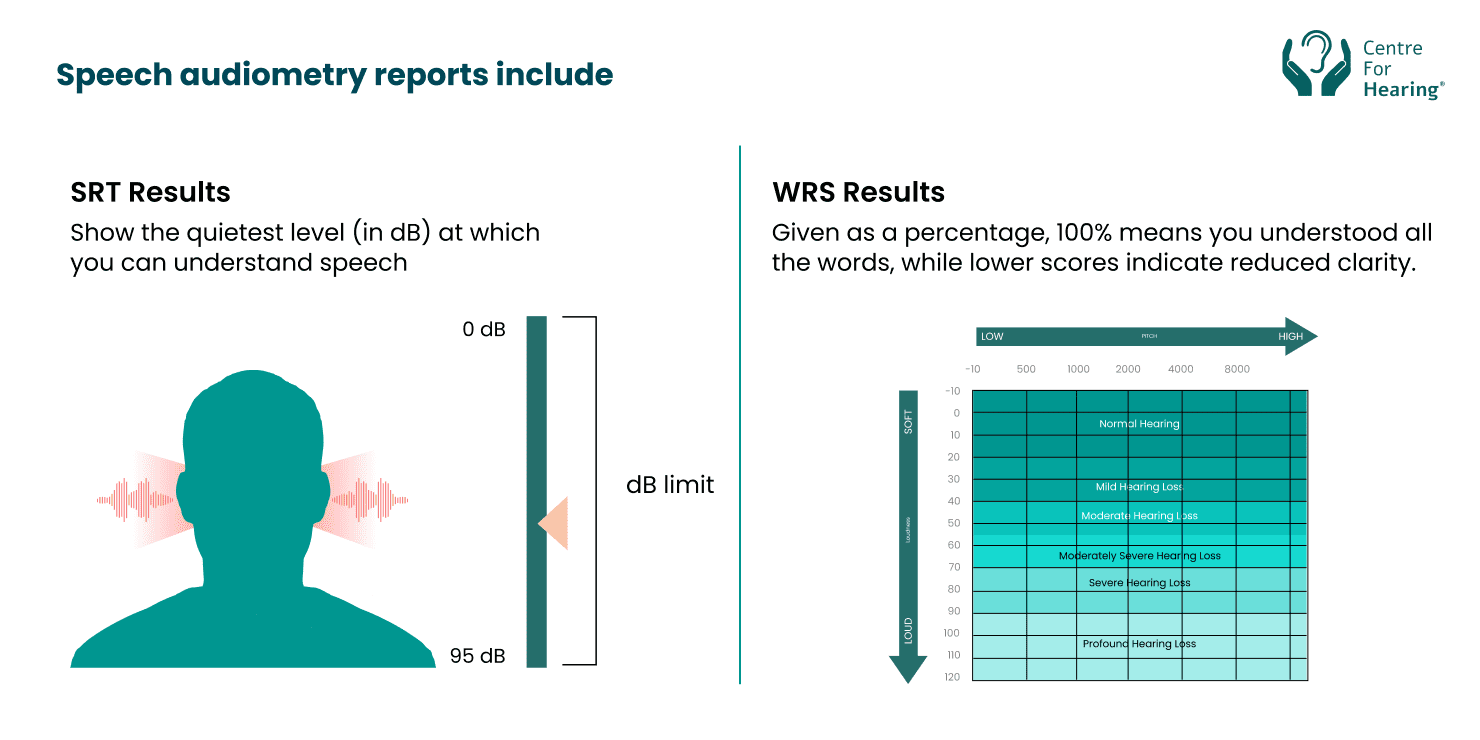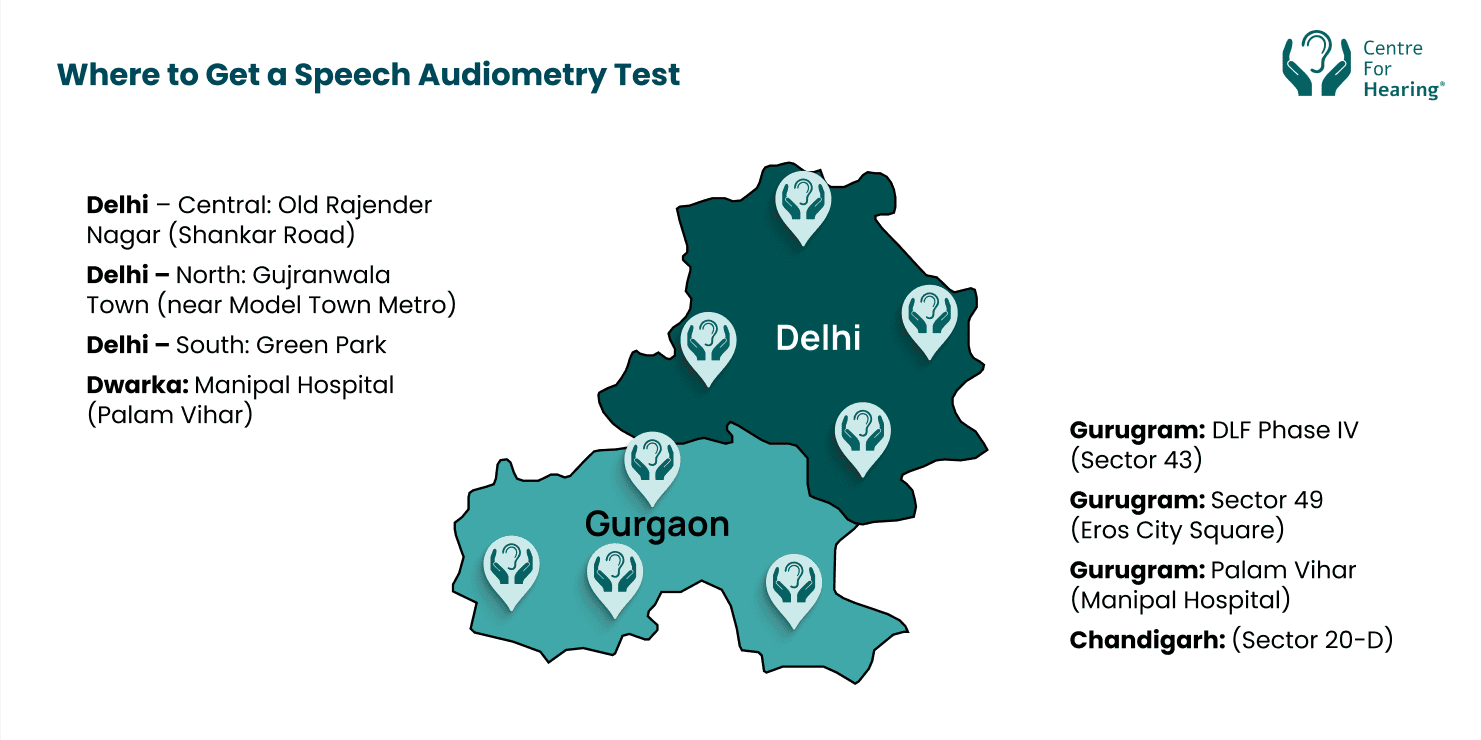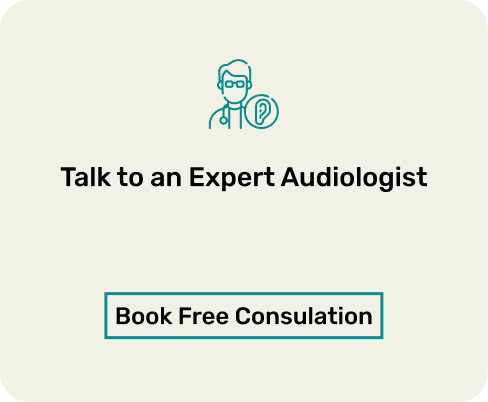Speech Audiometry is a specialised hearing test that evaluates not just the ability to hear sounds but also how well a person understands speech. It plays a crucial role in diagnosing hearing issues and shaping effective hearing solutions.
Understanding Speech Audiometry: More Than Just Hearing Sounds
Most people think a hearing test only measures how softly they can hear sounds like beeps or tones. While pure tone audiometry does exactly that, speech audiometry takes the assessment further by measuring how clearly speech is heard and comprehended.
Speech understanding is fundamental to everyday communication. You might hear a sound—like your name in a café or a colleague in a meeting, yet miss the words, especially in noisy settings. Speech audiometry measures how well your ears and brain process spoken language, revealing issues standard hearing tests may overlook.
Why is Speech Audiometry Important?

Speech audiometry offers insights that cannot be obtained with pure tone tests alone. It evaluates real-world hearing ability, ensuring that hearing aids or other treatments improve volume and clarity.
Here’s why this is essential:
- Speech Recognition: Evaluates your capacity to identify and understand words across varying volume levels, helping pinpoint problems with speech perception.
- Hearing Loss Diagnosis: It helps differentiate between types of hearing loss, such as sensorineural or conductive, providing a clearer diagnostic picture.
- Hearing Aid Fitting and Fine-Tuning: Accurate speech audiometry results allow audiologists to customise hearing aids so they amplify sounds in ways that enhance speech clarity.
- Communication Impact Assessment: The test helps understand how hearing loss affects daily conversations and social interactions.
- Monitoring Hearing Health: Routine speech tests can track the status of hearing ability over time, necessary for continued management.
What Happens During a Speech Audiometry Test?
The test is simple, non-invasive, and usually takes about 10 to 30 minutes. It is performed by an expert audiologist in a quiet, sound-treated environment.
Step 1: Setting Up the Test
You’ll be seated in a soundproof room fitted with specialised headphones or soft insert earphones connected to an audiometer. This allows the sounds to be presented exactly to both ears without any interference.
Step 2: Receiving Instructions
As the process starts, the audiologist will walk you through what to expect. Primarily, you would be asked to repeat words, sentences, or sounds you hear, even if they are soft or muffled. This helps measure both your hearing sensitivity and your ability to process speech.
Step 3: Speech Reception Threshold (SRT)
This test assesses the softest level at which you’ll accurately hear and repeat speech 50% of the time. You’ll be given familiar two-syllable words—such as “baseball” or “airplane”—at gradually reduced volume levels until your threshold is found.
Step 4: Word Recognition Score (WRS)
In this test, you’ll listen to a list of single-syllable words played at a comfortable loudness. You will have to repeat each word as clearly as you can. Unlike volume-detection tests, it measures speech clarity, revealing how well your brain understands words when hearing volume isn’t the challenge.
Step 5: Speech-in-Noise Testing
To simulate real-life listening, background noise is added in some tests, like street sounds or café conversations. You’ll be asked to repeat words or sentences while noise is being played, and see how well you can concentrate on speech under difficult conditions.
Step 6: Pediatric Adaptations
When testing children, traditional word lists are replaced with pictures, toys, or interactive games to make the test more engaging. Instead of repeating words, children may point to matching objects or pictures or respond using behavioural cues.
Interpreting the Results of Speech Audiometry Test

Speech audiometry reports include:
- SRT results: Show the quietest level (in dB) at which you can understand speech.
- WRS results: Given as a percentage, 100% means you understood all the words, while lower scores indicate reduced clarity.
Common result patterns:
- Normal hearing: SRT matches pure-tone average; WRS typically above 90%
- Sensorineural loss: Normal or near-normal SRT but reduced WRS.
- Conductive hearing loss: Elevated SRT but high WRS when speech is loud enough.
While SRT helps to verify pure-tone audiometry findings, WRS offers insight into speech clarity.
A low WRS may suggest more than just hearing loss; it can indicate retrocochlear disorders, auditory processing difficulties, or limitations in benefit from standard hearing aids.
These findings enable audiologists to recommend to you the most effective treatment, from hearing aids with specific speech-enhancement features to communication strategies for noisy settings.
Where to Get a Speech Audiometry Test

With over 3,00,000+ satisfied customers and trusted since 1973, Centre for Hearing® is one of India’s leading hearing care and audiology providers.
Our state-of-the-art facilities are designed to make you feel comfortable and at ease while ensuring every test is carried out with precision and care by experienced audiologists.
You can visit us at any of our conveniently located centres:
- Delhi – Central: Old Rajender Nagar (Shankar Road)
- Delhi – North: Gujranwala Town (near Model Town Metro)
- Delhi – South: Green Park
- Dwarka: Manipal Hospital (Palam Vihar)
- Gurugram: DLF Phase IV (Sector 43)
- Gurugram: Sector 49 (Eros City Square)
- Gurugram: Palam Vihar (Manipal Hospital)
- Chandigarh (Sector 20-D)
You can also locate your nearest facility here.
Note: Speech audiometry tests generally cost between ₹800 and ₹2,000, depending on the location and whether the test is a part of a full diagnostic package. Many insurance providers cover the test when medically prescribed.
FAQs
1: How long does a speech audiometry test take?
Most tests take around 10–30 minutes, depending on the number of subtests performed. If additional hearing assessments are included, the entire appointment may last longer.
2: Is the test uncomfortable or painful?
It is entirely painless and generally comfortable. You simply listen and respond. The sounds are well within safe listening levels, and the process is non-invasive.
3: Can children take this test?
Yes. Pediatric speech audiometry employs age-appropriate, modified methods such as games (Conditioned Play Audiometry), pointing to matching pictures, or demonstrating behavioural responses.
4: How often should speech audiometry be done?
Adults with no hearing concerns should have a baseline test, then follow-up tests every 3-5 years until age 50, and every 1-3 years thereafter. Those with existing hearing loss, a family history of hearing problems, or regular noise exposure should be tested annually.
5: How accurate is speech audiometry?
Speech audiometry is very accurate when it is performed in a sound-treated room by an experienced audiologist on calibrated equipment. Reliability is further enhanced when results are interpreted in conjunction with other hearing tests, standards consistently maintained at Centre for Hearing® facilities.
Final Note
Speech audiometry provides a more comprehensive understanding of hearing by measuring not only sound detection but also speech understanding, an aspect often missed in standard tests. Proper diagnosis through this aids in customising treatments that really enhance communication and quality of life.
If conversations feel unclear or hearing aids aren’t delivering expected results, a speech audiometry test could be the missing piece to your hearing care puzzle.
Schedule a speech audiometry test at Centre for Hearing®, where our sound-treated rooms (much quieter than a library!), calibrated instruments, and skilled audiologists guarantee accurate testing and clear, easy-to-understand insights.
To book an appointment, call us at 9811227269 or email us at care@centreforhearing.org.


















